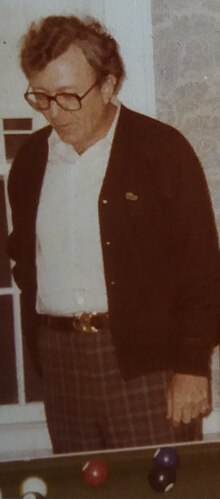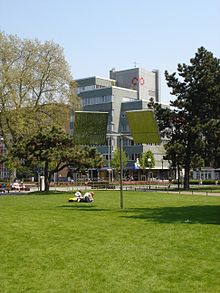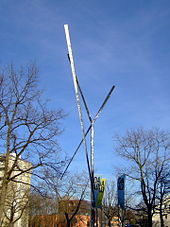George Rickey

George Warren Rickey (born June 6, 1907 in South Bend , Indiana , † July 17, 2002 in Saint Paul , Minnesota ) was an American sculptor .
Life
Rickey grew up in Helensburgh, Scotland , and attended Glenalmond College there . He studied history at Oxford . He traveled through Europe and studied art in Paris. Then Rickey returned to the USA and became a teacher there. His main focus was painting. He drew portraits himself. In 1942, Rickey joined the US Army and worked as an engineer in the aircraft and weapon systems research departments. After his discharge from the army, he studied art at New York University , the New York Institute of Fine Arts and finally in Chicago at the Chicago Institute of Design . George Rickey then taught at various colleges . He went to Indiana University , where he met David Smith , whose sculptures influenced him due to their material (stainless steel), their processing (surface texture) and their formal language (geometric and stereometric elements).
Artistic work
In the field of fine arts, especially in the 20th century - after many forerunners in antiquity, the Renaissance, the Baroque and the 19th century - there are various aesthetically demanding approaches for a metaphorical representation of the principle of permanent movement of artistic forms without artificial energy . Inspired by the kinetic sculptures of Alexander Calder , that of Marcel Duchamp with Mobile designated floating metal sculptures of the 30s, Rickey worked from 1945 to his first mobiles. In 1951, his first kinetic sculpture was shown in the American Sculpture group exhibition at the Metropolitan Museum of Art . Since that time he has been one of the most important representatives of kinetic art .
Most of his kinetic sculptures consist of a vertical metal rod, on the upper part of which - comparable to a tree crown - freely movable stereometric or needle-like formed elements are attached with the help of steel rods and special ball bearings in such a way that they perform an incomprehensible variety of motion sequences with the slightest draft without the plastic elements touching each other. Using highly developed technology and using the invisible natural forces of gravity and wind power, Rickey shows in a lyrical and playful way how movement can manifest itself without an electrical energy source.
Rickey was invited to documenta III in 1964, to the 4th documenta in 1968 and to documenta 6 in Kassel in 1977 . In 1965 the Museum of Modern Art New York acquired the large sculpture Two Lines - Temporal I (1964), which had previously been shown at documenta III . After documenta III he worked for many years in Berlin and from there he prepared his exhibitions in Europe. In 1968 and 1969 he received a scholarship from the German Academic Exchange Service (DAAD) in Berlin . During this time he created several works, some of which can still be seen in Berlin today. In 1967 he published his text collection Constructivism - Origins and Evolution, which gives a large overview of constructivist art and geometric abstraction up to kinetics.
The public outrage in 1973, when the city of Münster wanted to buy Rickey's sculpture Drei Rotierende Quadrate for 130,000 DM, was a reason for the later curators to bring the exhibition Skulptur Projekte to life in 1977 . The sculpture, which was acquired by the Westdeutsche Landesbank in 1975 and donated to Münster, is still there today. In 1974 Rickey was elected to the American Academy of Arts and Letters . In 1983 the Kunsthalle Mannheim acquired the kinetic wall sculpture Two Open Triangles up Wall II (1982). In 1987 his works were exhibited in the Roswitha Haftmann Modern Art gallery , Zurich. In 2016 a sponsor donated the free sculpture Four Lines Oblique Gyratory (1972) to the Städelschen Kunstinstitut in Frankfurt as an homage to Max Hollein.
In the 1990s, Rickey took over a professorship in sculpture at the Rensselaer Polytechnic Institute in Troy, New York. During these years most of his works were created in his New York studio in East Chatham. In 1979, a major retrospective of Rickey's work was held at the Solomon R. Guggenheim Museum , New York City. The last major presentation of his sculptures George Rickey: Kinetic Sculpture, A Retrospective, combined with an extensive catalog, was held in 2007 at the Vero Beach Art Museum.
George Rickey spent his final years in California near Santa Barbara and in Saint Paul, Minnesota . The National Academy of Design elected George Rickey a member ( NA ) in 2001 .
In 2002 he was posthumously awarded the Finkenwerder Art Prize.
Works
- Four squares in the square in 1969, terrace of the Neue Nationalgalerie , Berlin
- Two Rectangles Vertical Gyratory Down , 1970, Berlin
- Two lines oblique , 1970, DAAD, Bonn (formerly Kennedyallee , since 2010 Ahrstrasse)
- Three Lines Diagonal Jointed , 1984, broadcasting hall of the Hessischer Rundfunk , Frankfurt am Main
- Two Lines Excentric Jointed With Six Angels , 1987, Berlin Skulpturenboulevard
- Conversation , 1999, Ludwigshafen am Rhein
- Four Rectangles Oblique IV , 1984, Riedberg campus of the Johann Wolfgang Goethe University in Frankfurt
- Rectangles in the diagonal , 1984, kinetic object, outer wall of the painting school of the Kunsthalle Emden
- Lunge , eight-ship game in the Trigon building in Berlin
- Untitled , kinetic sculpture, Kunsthalle Bielefeld
literature
- Peter Anselm Riedl: George Rickey - Kinetic Objects , Reclam, Stuttgart 1970.
- George Rickey: Catalog 6/1973 of the Kestner Society, Hanover, for the exhibition from July 13th - September 30th 1973
- Art in public space. Sculpture Boulevard , Dietrich Reimer Verlag, Berlin 1987, ISBN 3-496-01039-8 .
- Jörn Merkert, Ursula Prinz: George Rickey , 1992
- George Rickey: Seven Kinetic Sculptures. Exhibition of the Utermann Gallery in the Sculpture Park Harenberg City-Center Dortmund , Dortmund, Harenberg, 1994 (not in the DNB catalog)
Web links
- Literature by and about George Rickey in the catalog of the German National Library
- "Who's who" about George Rickey
- Line of sight 5: Six Triangles Hexagon V
- Line of sight 7: Two Planes Vertical Horizontal Var III
- Materials by and about George Rickey in the documenta archive
Individual evidence
- ↑ For detailed information on the life and work of George Rickey see the website of the George Rickey Foundation http://georgerickey.org/index.html
- ^ Frank Popper: Kinetic art: light and movement, environmental art and action, DuMont, Cologne 1975. ISBN 9783770107681 . [1]
- ↑ George Rickey. Two Lines - Temporal I. 1964 | MoMA. Retrieved March 25, 2020 .
- ↑ George Rickey: Constructivism: origins and evolution , George Braziller Inc, New York 1967, revised edition 1995. ISBN 978-0807613818
- ^ Westfälische Nachrichten : How Munster Rickey learned to love
- ^ Members: George Rickey. American Academy of Arts and Letters, accessed April 22, 2019 .
- ^ Two Open Triangles up Wall II | Art gallery development. Retrieved March 23, 2020 .
- ↑ Ludmila Vachtova. Roswitha Haftmann . P. 104
- ↑ Four Lines Oblique Gyratory. Retrieved March 25, 2020 .
- ↑ Exhibitions | George Rickey, Kinetic Sculptor. Retrieved March 25, 2020 .
- ↑ http://georgerickey.org/pdf/rickey_collections.pdf
- ↑ nationalacademy.org: Past Academicians "R" / Rickey, George NA 2001 ( Memento of the original from April 2, 2015 in the Internet Archive ) Info: The archive link was inserted automatically and has not yet been checked. Please check the original and archive link according to the instructions and then remove this notice. (accessed on July 13, 2015)
| personal data | |
|---|---|
| SURNAME | Rickey, George |
| ALTERNATIVE NAMES | Rickey, George Warren (full name) |
| BRIEF DESCRIPTION | American sculptor |
| DATE OF BIRTH | June 6, 1907 |
| PLACE OF BIRTH | South Bend |
| DATE OF DEATH | July 17, 2002 |
| Place of death | Saint Paul , Minnesota |




